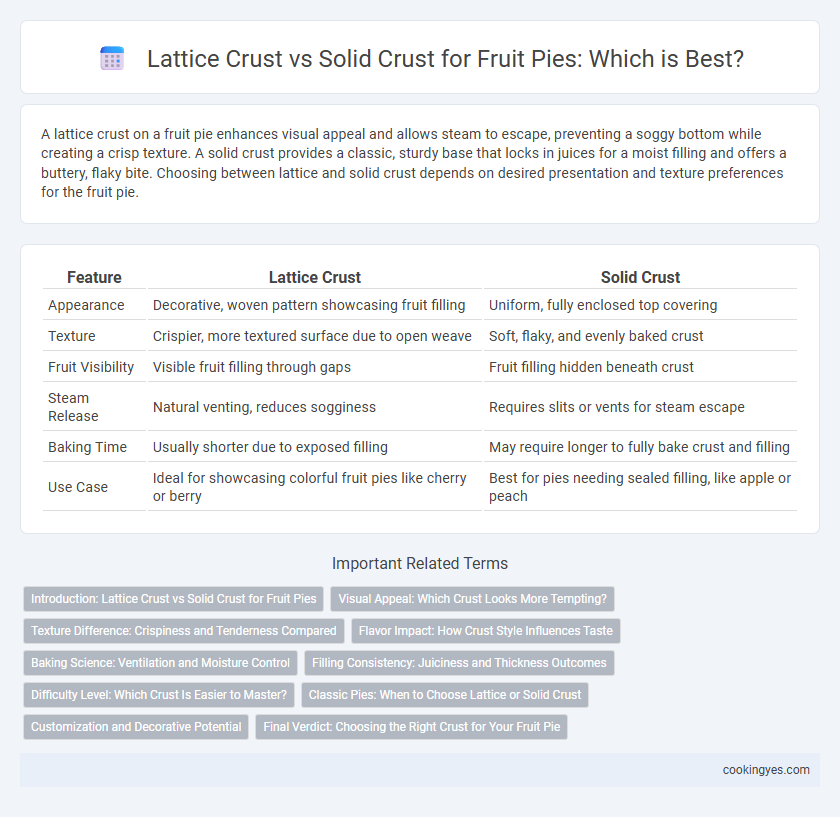A lattice crust on a fruit pie enhances visual appeal and allows steam to escape, preventing a soggy bottom while creating a crisp texture. A solid crust provides a classic, sturdy base that locks in juices for a moist filling and offers a buttery, flaky bite. Choosing between lattice and solid crust depends on desired presentation and texture preferences for the fruit pie.
Table of Comparison
| Feature | Lattice Crust | Solid Crust |
|---|---|---|
| Appearance | Decorative, woven pattern showcasing fruit filling | Uniform, fully enclosed top covering |
| Texture | Crispier, more textured surface due to open weave | Soft, flaky, and evenly baked crust |
| Fruit Visibility | Visible fruit filling through gaps | Fruit filling hidden beneath crust |
| Steam Release | Natural venting, reduces sogginess | Requires slits or vents for steam escape |
| Baking Time | Usually shorter due to exposed filling | May require longer to fully bake crust and filling |
| Use Case | Ideal for showcasing colorful fruit pies like cherry or berry | Best for pies needing sealed filling, like apple or peach |
Introduction: Lattice Crust vs Solid Crust for Fruit Pies
Lattice crusts offer a decorative pattern that allows steam to escape, helping fruit pies bake evenly and develop a caramelized fruit filling. Solid crusts provide a sturdy, enclosed design that locks in moisture, yielding a tender, flaky top layer with rich buttery flavor. Choosing between lattice and solid crusts depends on desired texture, presentation, and moisture retention in fruit pies.
Visual Appeal: Which Crust Looks More Tempting?
Lattice crusts showcase intricate, woven patterns of dough that reveal glimpses of vibrant fruit filling, creating an inviting and rustic visual appeal that tempts the senses. Solid crusts offer a smooth, golden-brown surface that can be beautifully decorated with cutouts or brushed with egg wash for a polished, classic presentation. The transparent texture of a lattice crust often makes it more visually enticing, highlighting the pie's juicy fruit contents and promising a flavorful bite.
Texture Difference: Crispiness and Tenderness Compared
Lattice crusts offer a unique balance of textures, combining crispiness from exposed dough edges with a tender finish where the strips overlap, enhancing the overall pie experience. Solid crusts provide a uniform tenderness throughout, creating a flaky, buttery exterior that contrasts with the juicy filling inside. The open gaps in lattice crusts allow steam to escape, preserving crispiness, while solid crusts retain more moisture, resulting in a softer texture.
Flavor Impact: How Crust Style Influences Taste
Lattice crusts enhance the fruit pie flavor by allowing steam to escape, concentrating the natural sweetness and tartness of the filling while creating a crisp, caramelized texture on exposed edges. Solid crusts offer a buttery, rich contrast that balances the juicy fruit with a tender, flaky layer, intensifying overall mouthfeel and providing a consistent flavor throughout each bite. The choice between lattice and solid crust is pivotal in defining the pie's taste profile, with lattice accentuating fruitiness and solid crust delivering a harmonious blend of pastry and filling.
Baking Science: Ventilation and Moisture Control
Lattice crusts enhance ventilation during baking by allowing steam to escape, preventing sogginess and promoting a crispier texture in fruit pies. Solid crusts trap moisture more effectively, which can result in a juicier filling but may cause a softer, sometimes undercooked bottom crust. The choice between lattice and solid crusts directly impacts moisture control and baking outcomes by regulating steam release and crust texture.
Filling Consistency: Juiciness and Thickness Outcomes
Lattice crusts allow steam to escape during baking, resulting in juicier fruit fillings that maintain a lighter consistency ideal for berries and softer fruits. Solid crusts trap moisture inside, producing thicker, more concentrated fillings suited for denser fruits like apples and cherries. Choosing between lattice and solid crust affects moisture retention and filling texture, influencing the pie's overall juiciness and structural integrity.
Difficulty Level: Which Crust Is Easier to Master?
Lattice crusts require precise cutting and weaving of dough strips, demanding moderate skill and patience to achieve an even, attractive pattern. Solid crusts involve rolling out a single sheet of dough, making them simpler and quicker for beginners to master with fewer chances of tears or uneven baking. For novice bakers, solid crusts offer a more forgiving and straightforward approach while lattice crusts enhance presentation but increase complexity.
Classic Pies: When to Choose Lattice or Solid Crust
Lattice crusts enhance classic fruit pies by providing a visually appealing, breathable top that allows steam to escape, preventing sogginess while showcasing vibrant fruit fillings such as cherry, apple, or blueberry. Solid crusts offer a sealed, tender barrier that locks in juices, ideal for dense fillings like peach or blackberry, delivering a rich, evenly cooked texture. Choosing lattice for lighter, juicy fruits preserves their freshness, whereas solid crust suits thick, custard-like or spiced fillings, ensuring a balanced structural integrity and moist interior.
Customization and Decorative Potential
Lattice crust offers greater customization through its intricate weaving patterns, allowing bakers to create visually appealing designs that enhance the pie's decorative potential. Solid crusts provide a smooth, uniform surface ideal for adding cut-out shapes or intricate embossing, making it suitable for personalized decorations. Both crust types enable unique artistic expressions, but lattice crusts emphasize openness and texture while solid crusts focus on detailed surface embellishments.
Final Verdict: Choosing the Right Crust for Your Fruit Pie
Lattice crusts offer a visually appealing design that allows steam to escape, resulting in a perfectly baked fruit pie with a slightly caramelized filling. Solid crusts provide a sturdy, sealed top that locks in moisture, ensuring a juicier and more tender fruit interior. Choose a lattice crust for decorative presentation and balanced baking, while a solid crust is ideal for maximum fruit juiciness and a classic pie finish.
Lattice crust vs solid crust for fruit pie Infographic

 cookingyes.com
cookingyes.com